Thérése Hegarty and Patricia Kennon explore picturebooks in learning contexts and how they allow a discussion of friendship, conflict, struggle, norms, points of view, difference and injustice in a distanced way, thus allowing sensitive issues to be discussed without direct disclosures about the children’s own lives.
Social, Personal and Health Education (SPHE) lessons offer a reflective space for children to articulate their learning in these areas, learning which develops as often outside of school as within.
Picturebooks can offer a rich medium as well as a safe space for SPHE lessons and the important yet challenging conversations that emerge.
Firstly they allow a discussion of friendship, conflict, struggle, norms, points of view, difference and injustice in a distanced way, thus allowing sensitive issues to be discussed without direct disclosures about the children’s own lives.
Secondly they can bring the world into the classroom in a way that allows the teacher mediate discussions about those global tensions which children are exposed to but may be overwhelmed by.
Thirdly they offer an empowering stimulus for drama, reflection and discussion, creative writing and cross-curricular research, teaching and learning.
We identified ten SPHE themes (identity, feelings, decisions, friendship, safety, peace and conflict, family, citizenship, global children’s narratives and the environment) and exemplified each theme with five picturebooks.
In writing discussion questions for these picturebooks and their associated themes, we were guided by a wish to scaffold for children what Martha Nussbaum describes as ‘narrative imagination’ in her book Not for Profit: Why Democracy Needs the Humanities published in 2010:
‘This means the ability to think what it might be like to be in the shoes of a person different from oneself, to be an intelligent reader of that person’s story, and to understand the emotions and wishes and desires that someone so placed might have …. So we need to cultivate students’ ‘inner eyes,’ and this means carefully crafted instruction in the arts and humanities — appropriate to the child’s age and developmental level-that will bring students into contact with gender, race, ethnicity and cross cultural experience and understanding.’
All fifty picturebooks have been published since 2010 in order to present up-to-date examples of contemporary international literature for young people, especially in light of the 2016 SHPE Network conference theme of change over the last 100 years.
We have been asked if some of these books would frighten children or if the scenarios they pose are too complex. We rely on the professionalism of teachers to choose the timing and pacing of content as well as the suitable level of scaffolding of the learning. But in a world where so many children live without food security and so many are displaced, we believe that those who live in relative security need to know about the power relationships in which they live and the possibilities for change.
In inviting children to imagine the lives of children in all the complexity of a different context and consider how we are related across time, place, and privilege, we want them to articulate ethical responses to the lives of others and live consciously as global citizens. Ultimately our hope is that an exploration of all these books could support children develop more compassion, more agency and a search for justice.
Note: this feature is based on titled ’50 Picturebooks to Change the World!’, a workshop document produced by Thérèse Hegarty and Patricia Kennon, Maynooth University, for the SPHE Network conference in November 2016.
1. Identity
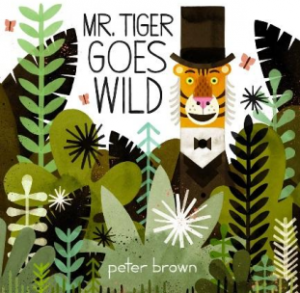
Mr Tiger Goes Wild
Peter Brown
This warm, playful picture book for junior classes about the pressures of conformity and the importance of accepting and welcoming difference encourages all children to embrace their true, unique selves, just like Mr Tiger dares to do! Working simultaneously across the strands ‘Myself’, ‘Myself and Others’ and ‘Myself and the Wider World’, the relationship between identity and the constraints of social living can be explored in a simple way. The story also supports the valuing of difference in a subtle way. It lends itself to PE, drama movement and dance as opportunities for children to engage with the story in more embodied ways and to experience the freedom the story offers.
- How did you feel when Mr Tiger went to the wild? Can you explain?
- What do you think happened to make others change?
- If you could make one change to the way we live together, what would that change be?
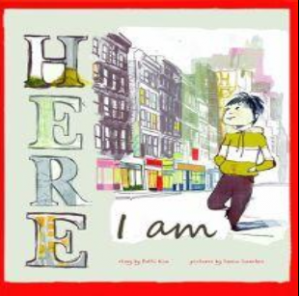
Here I am
This picture book for junior classes sensitively explores the difficulties, adjustments and eventual triumphs that an immigrant young boy faces when he and his family move from Korea to New York City. The book’s near-wordlessness echoes the protagonist’s unfamiliarity with his new environment as he negotiates a kaleidoscope of new sensations, emotions, challenges and experiences. The story invites us to take a walk in unfamiliar territory ourselves to discover what we don’t yet know or understand. Alternatively such journeys could be created with Drama, PE and Music lessons and reflected on during circle time and SPHE activities.
- Can you explain why the boy found some of the things and places in New York very strange?
- We see him curled up at a window looking out many times. What was he thinking?
- How do you make a friend?
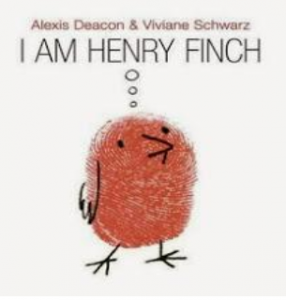
I am Henry Finch
Alexis Deacon & Viviane Schwartz
This valuable and engaging picture book for all ages poses philosophical questions about the relationship between an individual and one’s community. What happens when Henry, one of a huge flock of finches, starts to think for himself? Danger and doubt beset Henry but he survives and shares what he has learned with the others, sparking a cascade of enriching and collaborative possibilities. This story provides an opportunity for children to be quiet and notice their thoughts, with their eyes closed, while listening to music, while on a short silent nature walk, when looking at a picture etc. Circle time sessions after any of these activities could begin with ‘I listened to my thoughts and I heard….’ Along with developing self-awareness this can really support listening skills and empathy and an appreciation that we all have different responses to the same stimulus.
Do you think Henry was like all other Finches or was he somehow different? How?
How did listening to his thoughts help Henry in this story?
Have you ever listened to your thoughts? What did you hear?
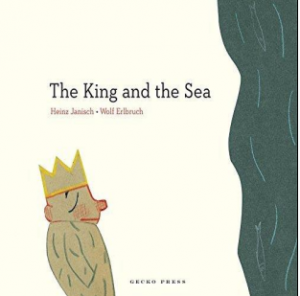
The King and the Sea
Heinz Janisch & Wolf Erlbeuch
This thought-provoking collection of twenty one extremely short stories (translated from German) consists of a series of alternatively wry and poignant dialogues between the titular king and various inhabitants of his kingdom. The book offers rich cross curricular and project opportunities for 2nd to 6th class including drama, art and creative writing activities where the conversations could be extended or other conversations imagined about the nature, extent and limitations of power. An
exploration of the role of kings in today’s world or in history could further explore what kingship means, could mean and should mean.
Did you have a favourite page? Can you explain why?
How might this king be different from your idea of what being a king means?
What do you think the King learned through all his meetings and conversations?
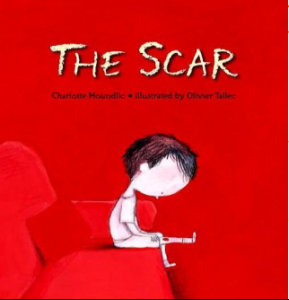
The Scar
Charlotte Moundlic
This compassionate book depicts a young boy’s struggle with bereavement after his mother dies. Quirky humour and skillful use of colour counterbalance the rawness of the boy’s fluctuating emotions in this honest and powerful account of grieving, distress, isolation, and ultimate acceptance of loss. Sadness, anger, fear, confusion are all here along with the child’s agency in renegotiating other family relationships. It would be a very useful book to explore loss in the classroom as part of an SPHE feelings theme. Teachers need to reflect on when best to introduce a book about loss, taking care not to confront a recently bereaved child or place them too much under the spotlight.
- When his mother dies the little boy had a lot of strong feeling in the first few days. Can you remember what some of those feeling were?
- How does the boy keep his mother’s love close to him after she is gone?
- Do you think Grandma should visit again? What might she and the little boy might do in the future?
2. Feelings
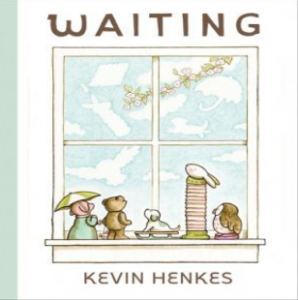
Waiting
Kevin Henkes
Five toy figurines wait on a windowsill as young readers are invited to share the existential joy of waiting while grappling with dilemmas and anxieties around safety, chance, change and adapting to unexpected events. The story offers an invitation to a valuable range of watching and waiting exercises: watching the clouds; watching the rain fall; waiting for seeds to germinate; waiting for a sunny day to go on a walk; waiting for a full moon; waiting for the birds to build their nests. Children can learn to practise patience, to consider the role and value of waiting, impulse control, resilience and adaptability, and to respect the cycles of nature.
- Can you describe some of the things the toys noticed while they were waiting?
- The toys never seemed to give up waiting. Why do you think this was?
- Have you ever waited a long time for something to happen? Would you like to share your story?
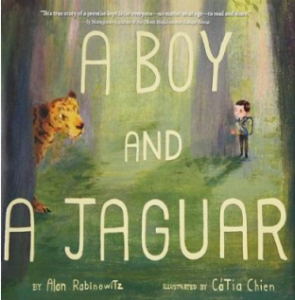
A Boy and a Jaguar
Alan Rabinowitz
This moving autobiographical account for the middle classes captures the importance of empathy and how enriching working with animals can be. The emotional resonance of the text, evocative illustrations and the urgency of the issues addressed all combine in a rich and thought-provoking experience. The book offers an entry into research about protected species, conservation, environmental care and animal rights in SESE. In SPHE children could explore their own promises and what underlies them. In persuasive writing and drama, children would write Alan’s speech and perform the scene when he meets the Prime Minister of Belize.
- How do you think Alan was able to speak fluently to animals?
- What do you think he meant when he said he felt ‘broken’?
- Can you find a word to describe Alan and explain why you chose that word?
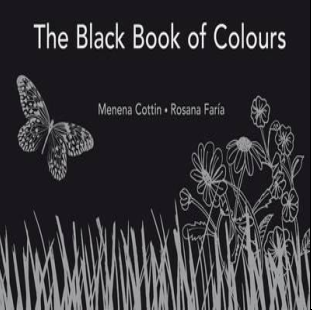
The Black Book of Colours
Menena Cottin & Rosana Faria
This immersive book invites its sighted readers of all ages to experience colour through the lack of colour. Depicting a series of natural objects from rain to bird feathers to strawberries through Braille and embossed lines on black paper, this thought-provoking experience promotes empathy, inclusion and the creative investigation of concepts of colour through tactile sensations. This book offers links to sensory walks, blindfolded exercises, working with texture in visual art and visualisation and mindfulness exercises. It also offers an entry to Braille to learning the alphabet, the history of Braille and research on the extent of its use.
- What new thoughts or questions came to you as you read this book?
- If we could not see in this classroom, how would our sense of touch develop?
- If you could add another page to the book to explain the colour purple, how would you design it?
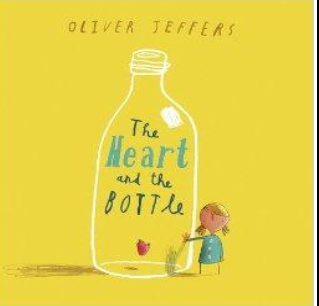
The Heart and the Bottle
Oliver Jeffers
Once there was a girl whose life was filled with all the wonder of the world around her. Then one day something occurred that caused the girl to take her heart and put it in a safe place. However, after that it seemed that more things were empty than before. Would she know when and how to get her heart back? This deeply touching story offers a question so profound that it seems a pity to explore it too literally. It speaks strongly to adults as well as children across age groups. It might be best to let it work it’s magic on each child in its own way. The classroom could have a ‘wondering chair’ which children could sit on and listen to their thoughts and wonder about things. Perhaps their wonderings could be expressed in visual art, music or drama.
- Why do you think the girl decided to put her heart in a bottle?
- Why do you think we have a heart anyway?
- What kinds of things are you really curious about?
The Dark
Lemony Snicket
A boy’s fear of the dark is skilfully rendered in this deliciously tense yet sensitive story for junior classes. The inspired pairing of Lemony Snicket’s suspense-filled text and Jon Klassen’s minimalist illustrations creates a memorable and cathartic story experience for readers of every age. This lesson can be developed in SPHE to explore fears in general, fears children had in the past that they no longer hold, dark places in the environment which children need to avoid for their own safety or places where they should not go alone. In SESE children can explore ways of creating light, the times of the day when it gets dark throughout the year and the influence of light and dark on growing plants.
- What was the scariest part of the book for you?
- Do you think Laszlo did the right thing in following the dark right down to the basement? Why?
- How much light or darkness do you like around you so you can fall asleep safely?
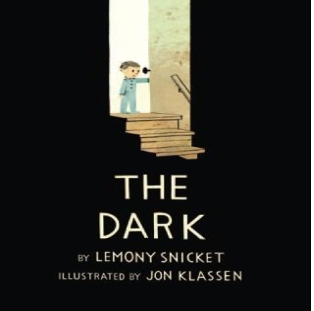
3. Decisions

Red
Jan de Kinder
Torn between her fear of the bully in the school playground and her sympathy for her classmate, a girl must make a difficult choice. This powerful book (translated from Flemish) explores the role of the bystander in bullying. Every child witnesses nasty behaviour and has to choose to join in, to stay silent or to speak against it. Through exploring the decisions of the little girl in the story, children can clarify their own position on bullying. The sparse text and intense emotional illustrations skilfully explore moral dilemmas and the bravery and complicity of everyday life in the playground while opening up a safe space for important conversations about the challenge of taking a stand.
- What might Tommy be thinking or feeling when the others whisper about him?
- Why does the girl stay silent when she wants to scream?
- Later she made a decision to put her hand up and speak. How do you think she made that decision?
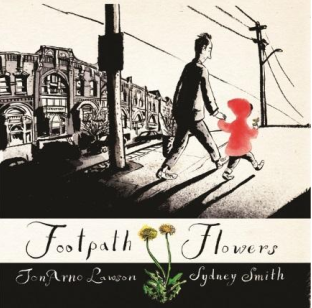
Footpath Flowers
JonArno Lawson & Sydney Smith
A wordless Canadian picture book for junior infants to 2nd class which traces a father and daughter’s journey through grey city streets that gain colour through the girl’s various acts of observation, giving and kindness. A poem honouring the importance of small things, small people and small gestures, this book invites us to open our eyes to the little things we miss or take for granted. The story quietly but powerfully invites us to walk along our everyday paths and look more closely. Rich with cross curricular potential, the book could offer a starting point for a nature walk, creative writing, drama and music activities or a walking meditation.
- Can you find a word to describe this little girl? Why did you choose this word to describe her?
- What was important to her and can you guess why?
- What wild flowers and plants do you pass by on your own way to and from school?
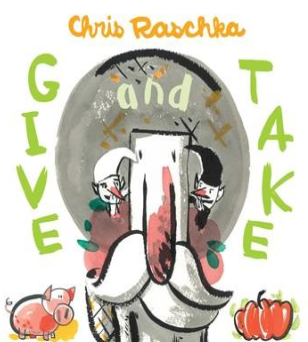
Give and Take
Chris Raschka
This fable (with which the middle classes would engage well) about a farmer tempted to give and take without any regard to his own or anyone’s needs and wellbeing explores the importance of moderation and compromise. Cross curricular and project based opportunities could include an exploration of fair trade at a local and/or at a global level as well as stimulating reflection, debate and discussion about different points of view, the importance of balance in one’s life and what each child brings and takes from cooperative work in the classroom.
- If you could choose would you rather live a life of always giving or a life of always receiving? Why?
- The farmer took all the pumpkins but he did not need them. What sorts of things do you see people taking that they do not need?
- Can you tell a story about a time when you gave something and took something and it was better for
everyone?
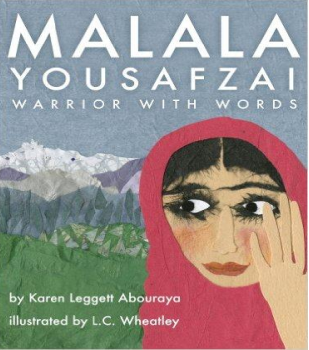
Malala Yousafzai: Warrior with Words
Karen Leggett Abouraya
‘We will bring change through our voice’. ‘Our words can change the world’. This inspiring story for the junior and middle classes celebrates courage, resilience, compassion, empathy, the power of education and how one young person can make a difference. The collage illustrations provide texture and vibrancy while supplementary informational resources about Pakistan and the Malala Fund (the United Nations Foundation’s Girl Up program) would stimulate project work and invite further research on the UN Global Goals, the position of women and girls locally and globally and the issue of females of all ages in education in particular. It allows for the writing and delivery of speeches on issues of importance to the children themselves which link to the Global Goals.
- What do you admire most about what Malala has done?
- What would you like to understand more about as you read through the book?
- What do you think Irish children can do to change a world where many children cannot go to school?
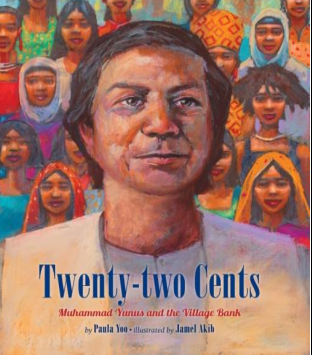
Twenty Two Cents: Mahummad Yunus and the Village Bank
Paula Yoo
Muhammad Yunus witnessed extreme poverty in the region that is now known as Bangladesh and was determined to eradicate it by making small loans at very little interest to local people considered to be ‘banking untouchables’. This thought-provoking account, suitable for 3rd to 6th class, chronicles the work of this Nobel Peace Prize winner and will stimulate important discussions about power, inclusion, prejudice, economics and social justice. Children could conduct further research on Grameen bank and map out the countries where it operates. They can link this to their study of interest rates in maths. They could link microfinance to the 2015 Global Goals. They could also learn about the Nobel Peace Prize and find out about others who won the prize.
- Why do you think Muhammad Yunus decided to return to Bangladesh if he had a good life in America?
- Lots of people have good ideas but why do you think Mohammed followed through with his good idea?
- What do you think the word ‘microfinance’ means or what else would you like to understand about microfinance?
4. Safety
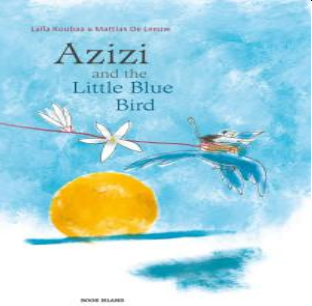
Azizi and the Little Blue Bird
Laila Koubaa
Azizi lives in a country governed by dictators who imprison all blue birds as part of their regime of fear and oppression. One of the blue birds escapes and helps Azizi rescue the other birds and end the rule of the oppressive tyrants. This Flemish contemporary fairytale, suitable across 1st to 4th class, is inspired by the censorship of the internet by various governments and especially the Jasmine Revolution in Tunisia, and explores issues of multiculturalism, oppression, freedom, the importance and role of free speech, and the power of social media for empowerment and democracy. While references to real regimes are veiled the story offers an opportunity for children to discuss themes of power, greed, wealth and freedom and articulate their ideas on governance and freedom. They will bring whatever knowledge they have to the meaning making.
- The book tells us that Tih and Reni ruled with an iron hand. What do you think this means?
- What worried you about the lives of the people in the Land of the Crescent Moon?
- Now that Tih and Reni have lost their power how do you think the country should be ruled?
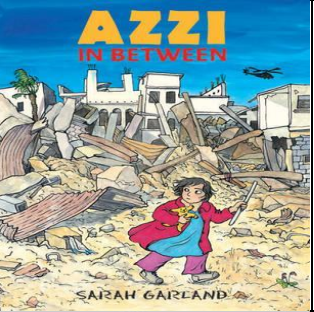
Azzi in Between
Sarah Garland
This moving yet humorous story for 2nd-4th class follows a refugee family’s difficult journey to another country where Azzi must face the challenges of finding a new home, learning a new language, trying to make new friends and starting a new school. While the book invites empathy for the experiences of refugees, a strength of the story is that no particular countries are named. It
does however invite an exploration of conflict, forced migration and the places in the world today from where children and their families are forced to flee. This could lead to an in-depth study of one of those countries and its recent history.
- What do you like about Azzi? Why?
- What do you think was the most difficult day in her life?
- What would you hope will happen for her when she settles into school?
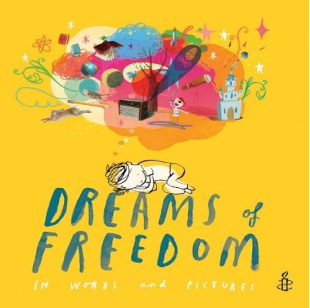
Dreams of Freedom:
Amnesty International
This inspirational and accessible book for the middle and senior classes presents 17 quotations from human-rights leaders which are visually interpreted by international artists. The book presents a diverse range of aspects of freedom, inviting young readers to reflect about the global fight for social justice and their own agency regarding social change. This book will inspire research into the lives of the poets and artists. The children’s learning could be presented to the class and they could be challenged to imagine how the artist would answer the questions of their peers.
- Choose the Dream that stood out for you most. Why?
- What do the illustrations on that page mean to you? What do the words mean to you?
- What does Freedom mean to you? Can you illustrate your idea and add some words?
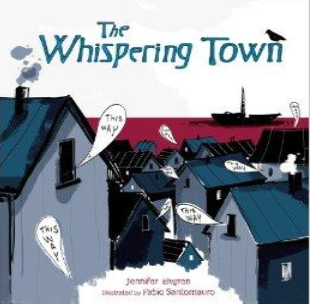
The Whispering Town
Jennifer Elvgren
Based on a true story about neighbours in a small Danish fishing village who, during the Holocaust, shelter a Jewish family waiting to be ferried to safety in Sweden, this picture book (suitable for 2nd-4th class) poses dilemmas for its readers in an accessible yet challenging way. This book grounds the history of the second World War in the lives of ordinary people and can make the story of war accessible to children. It offers a powerful stimulus to explore fear, safety, risk, friendship and community. The teacher has the choice to remain with the context of Denmark in WW2 or to extend the conversation to the places where such risks are being taken today.
- Can we name all the feelings Anett described in this story?
- Papa called her ‘Brave Anett’. In what ways did she show bravery?
- What words would you use to describe the people of the town? Explain your choice of word!
Unspoken: A Story from the Underground Railroad
Henry Cole
This historical wordless story (suitable for 4th-6th class) of the Underground Railroad during the US Civil War poses uncomfortable but crucial questions about freedom, voice, agency and who is considered human. Cole creates tension and emotional resonance in this powerful tale of quiet camaraderie and courage. The story opens space for a study of those who in history or in today’s
world have been forced to flee to safety. It could also offer an opening to study slavery and the civil rights movement in the USA as well as the struggles of today’s refugees and their treatment in Ireland and around the world.
- What risks does the runaway slave take on his northward journey and why might he take such risks?
- What risks does the little girl take in the story?
- Have you ever taken a risk to help someone? Tell the story!
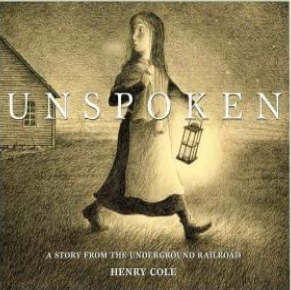
5. Friendship
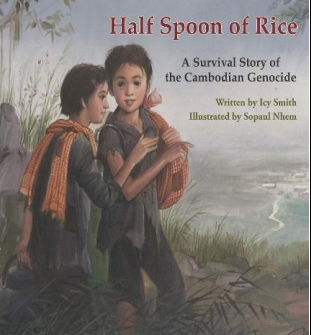
Half Spoon of Rice: A Survival Story of the Cambodian Genocide
Icy Smith
Nine-year-old Nat is forced out of his Cambodian home and marched into the countryside when the Khmer Rouge comes into power. This unsentimental and moving book for 3rd to 6th class charts how Nat confronts starvation, fear, brutality and forced labour over the next four years, eventually reuniting with the family he loves. This book offers an age appropriate account of the Khmer Rouge regime and the challenges of the Cambodian people to survive. It also introduces the idea of refugee camps and refugee resettlement programmes. By exploring this story from the 1980’s, refugee experiences can be explored without any child in the class themselves having to take the spotlight.
- When Nat and Malik are working in the fields for four years what do you imagine they missed most?
- What difference do you think Nat and Makik’s friendship made to their lives during the four years?
- When they came to San Francisco and started school, how might their classmates have supported them to settle into their new country?
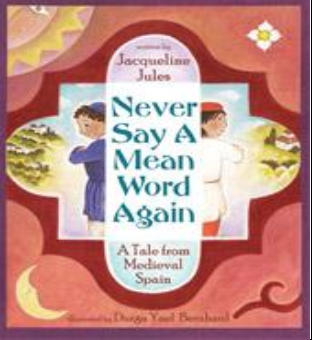
Never Say A Mean Word Again: A Tale from Medieval Spain
Jacqueline Jules
Inspired by a legend of conflict resolution in medieval Muslim Spain, this is a story of a boy who is given permission to punish an enemy. What will he do? The protagonist’s dilemma of how best to deal with an aggressor and how to constructively address injustice is especially significant in light of contemporary ethnic violence, hatred and cycles of revenge. This picture book could act as a stimulus for SPHE and DICE discussion for 1st to 4th classes. This story provides a rich opportunity for conflict resolution and values clarification in SPHE. Name calling does not emerge without context. Status and power influence who can befriend whom. Children can explore responsibility, discriminate between intentional and unintentional hurt and explore friendship in a distanced
way through this story.
- If you could make friends with either Samuel or Hamza, which one would you choose and why?
- Why do you think Samuel’s father did not want to sort the problem himself?
- What was the greatest lesson Samuel learned?
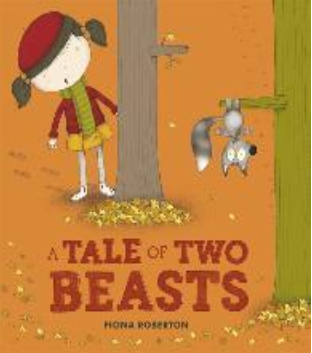
A Tale of Two Beasts
Mona Roberton
A girl finds a strange beast in the forest, takes it home as a pet, feeds it, gives it a hat and shows it off to her friends. But that night it escapes. Then the beast tells its story of being ambushed and kidnapped by a terrible beast who carries it off to a secret lair, feeding it strange food and forcing it to wear strange things. The alternating perspectives of this witty, thought-provoking story for junior infants to second class address point of view and the narratives we tell about ourselves and others. One way of introducing this book is to discreetly allow half of the class to hear one version and the other half to hear the second version. They could subsequently read both and reflect on the two perspectives as well as retell other stories from alternative characters’ perspectives. Older children will see this as a metaphor for historical events where oppression was constructed as rescue.
- Do you think the little grey beast was rescued or ambushed by the girl beast?
- When, if ever, is it right to take beasts away from their natural habitat?
- In the end it looks like the two beasts might become friends. If they are to stay friends what will each one need to understand about the other?
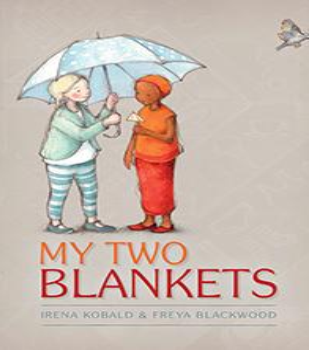
My Two Blankets
Irena Kobald & Freya Blackwood
Cartwheel has moved to a place that is so strange to her, she no longer feels like herself. She creates a safe place for herself under an ‘old blanket’ made out of memories and thoughts of home. As time goes on, Cartwheel begins to weave a new blanket, one of friendship and a renewed sense of belonging. This thoughtful story explores the challenges of migration and allows for a sharing of the mother tongue of the children in the class and an appreciation of the diversity of languages. Children could pair up and bring each other words as gifts. In classes where all the children are of Irish ethnicity, children can bring Irish words to share and create scrapbooks of the words they learn from each other. Parents and families could be involved. Older children could research the languages spoken worldwide and the history of how languages have spread.
- What was your first language? Where and when do you speak it?
- Do you understand what Cartwheel means by ‘the cold waterfall’? Have you even felt something like this?
- Can you think of ways to make friends with someone who does not speak the same language as you?
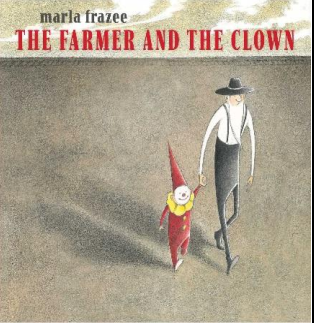
The Farmer and the Clown
Marla Frazee
This wordless picture book for the junior classes richly explores the risks and benefits involved in opening oneself to unexpected friendship. Every page in the book offers a rich opportunity for language development, dramatic enactment and exploration of thoughts and feelings. The farmer moves through bafflement to contemplativeness and finally to true affection in this accessible yet emotionally rich chronicle of the power of companionship and compassion. Frazee’s skilful use of negative space, line, light and shadow will stimulate visual art as well as dramatic and creative writing activities.
- What do you imagine the farmer and the clown spoke about that night?
- What did the clown learn about farming?
- Look at the faces of the clown family when the young clown returns to them. What do their faces tell us about what they might be thinking or feeling?
6. Peace and Conflict
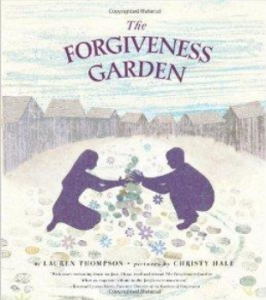
The Forgiveness Garden
Lauren Thompson
In this allegorical story (suitable for the junior classes) inspired by a real Garden on Forgiveness in Lebanon, two fictional villages, Vayam and Gamte, are at war. When a Gamte boy, throws a rock and injures a Vayam girl, revenge is expected. Instead she forgives her attacker and uses rocks to begin building a garden that the two communities can share. Addressing the courage needed to step out of conflict, the story opens space for an exploration of the values that underpin a decision to forgive. Children could use conscience alley to understand the process for Sama and Karune and imagine the support and resistance the two will find in their own communities. Moving beyond the book children can discuss how difficult forgiveness can be. They can learn about the memorial garden in Omagh and research other places where gardens have been created to offer resistance to conflict.
- Which was worse for the people of Gamte and Vayam, being angry or being afraid?
- When Sama looked at her scowl and asked herself, ‘What have I become?’ and cried, what do you imagine she was thinking?
- What did Sama and Karune have to give up to step into the forgiveness garden?
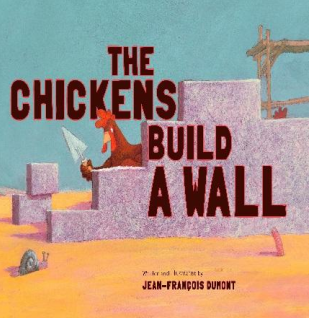
The Chickens Build a Wall
Jean-Francois Dumont
The chickens at the farm are building a wall and no one is quite sure why. But they know one thing: the hedgehog that wandered in must be trouble. A clever barnyard commentary for junior infants to third class on xenophobia, prejudice and overreaction. The book offers an opportunity to explore difference and our defensive response to strangers. It opens the topic of xenophobia in a way that evokes Armin Greder’s The Island but allows a discussion at a much younger age. With older children
the discussion about suspicion and defence can be linked to contemporary society or school dynamics. Children could be invited to retell the story from the point of view of the hedgehog or dramatise scenes developing alternative storylines.
- Do you think all strange creatures are dangerous?
- Did the wall make life better or worse for the chickens? Explain why you think so.
- Why do you think they all agreed to the roosters’ plan?
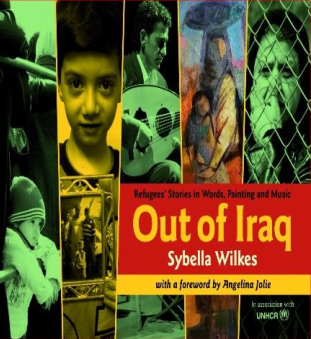
Out of Iraq: Refugees’ Stories in Words, Paintings and Music
Sybella Wilkes
Since 2006 hundreds of thousands of Iraqi refugees have fled to neighbouring countries to escape the terror and confusion of war. Presenting the personal accounts of some of these displaced people, this evocative book of stories for the senior classes will prompt discussion about war, the status and treatment of young and older refugees, the experience of living under conflict conditions and the effects of conflict on civilians. The book would also act as a powerful invitation for further research and project work across the curriculum. A teacher could select a number of stories to read to the class, leaving the entire book on the investigation table or in the library as a resourse for futher study. The questions here are based on Ahmed’s story, Flight: a child’s memory of invasion.
- How do you think Ahmed spent his day when it was not safe even to go to the garden?
- ‘No space for my toys’ What do you imagine Ahmed felt that day’?
- ‘Maybe next year it will be safe to return’ How do you think Ahmed and his family stayed hopeful?
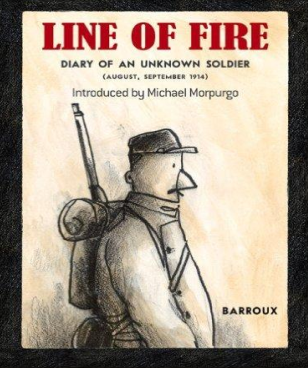
Line of Fire: Diary of an Unknown Soldier (August, September 1914)
Michael Morpurgo
Chronicling the experiences and struggles of an unknown soldier during the trenches of World War 1, the spare text, balanced tone and stark illustrations powerfully evoke the grim territory of no man’s land and explore the challenge of not succumbing to jingoism and hatred amidst a time of war. This thought-provoking book offers a valuable experience for critical literacy and debate for fourth to sixth class. The book offers rich cross-curricular links to history, geography, dramatic role play, charcoal drawing, SPHE discussions about conflict, nationality and patriotism, persuasive texts and letter writing. This story could be a valuable starting point for philosophy circles on life, death, camaraderie, loss and violence.
- As you read the book what stands out for you as the hardest part of the life of a soldier in war?
- If you could have sent a message to the unknown soldier during 1914 what would you have put in that message?
- Do you think war can ever be a good thing?
Green Lizards and Red Rectangles
Steve Anthony
The green lizards and the red rectangles are at war, but neither can defeat the other. Antony’s inventive compositions provide variety and skillfully evoke the chaos of war. He also powerfully uses these same elements to illustrate the rivals’ eventual reconciliation. In a world where violence and war are claiming millions of lives it is important to question the meaning and the cost of fighting from a young age. This deceptively simple story offers an entry for all classes into mediation training and restorative practices in schools along with an analysis of the current wars, the context of those wars and the requirements for peace.
- What do you think they were fighting about?
- What good things were the green lizards and the red rectangles missing out on when they spent so much time fighting?
- If you were in a fight, when would you call ‘enough is enough’? How do you think they worked out the solution?

7. Family
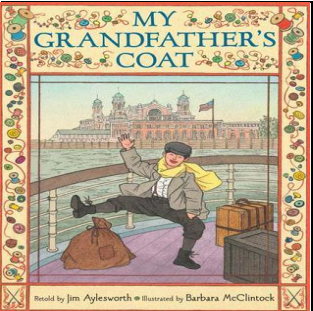
My Grandfather’s Coat
Jim Aylesworth
This energetic and witty rhyming adaptation of a Yiddish folk song of how a coat has been repurposed and refashioned over decades of use celebrates the ingenuity and resourcefulness of many immigrant families. The story (suitable for the middle classes) is a moving tale of love and regeneration and offers an introduction to upcycling. Children could bring an old piece of clothing to school and make a soft toy using stitching. Children could also take a critical look at our waste and the environmental impact of replacing rather than repairing items.
Jim’s grandfather made one thing after another with the material for the coat.
- Why do you think he never threw things away?
- Do you have an old thing that you would never throw away?
- Jim’s grandfather was skilled at making things from fabric. What skills do your grandparents have?

One Family
George Shannon
This playful counting book for the junior classes celebrates family and human diversity and promotes the important message that everyone counts. The different groupings of things and members of multi-ethnic, multigenerational families emphasise the idea of unity in multiplicity: ‘One is six. One line of laundry. One butterfly’s legs. One family’. It is important that we resist any normative ideas of family with children. When we ask children to tell us who is in their family they should decide who to include. This can allow for an appreciation for diverse family forms. Older children could create a page to depict their family and include the number groups as in the book. It could be a book project for the class.
- Which page do you like most and why?
- You can choose one of the families and ask them a question. What would your question be?
- How many grown-ups and how many children are in your family?
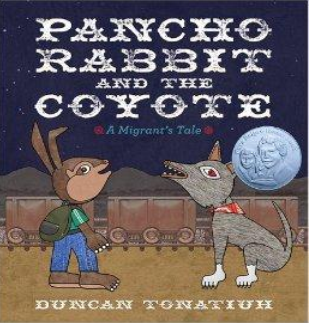
Pancho Rabbit and the Coyote: A Migrant’s Tale
Duncan Tonatiuh
Papá Rabbit leaves Mexico one spring to find work in the US to feed his family when there is no harvest in his fields. On the night of his planned return home, the family prepares a special homecoming for Papá Rabbit. When he does not arrive, his son, Panchito decides to search for his father and accepts Coyote’s offer to guide him toward the US border. This allegorical story for
the middle and senior classes skilfully balances folkloric elements with stark, modern realities regarding prejudice, stereotypes and media bias in its exploration of Central American migrant experiences to the US. Cross curricular opportunities include exploration of Mexican food and music, the history of migration to the USA for work and the impact of climate change.
- What do you like or admire about Pancho’s family and how they care for each other?
- What kinds of feelings do you imagine Pancho, his Papa and his Mama felt during the time when Papa was working in El Norte?
- What was the greatest risk Pancho took when he travelled to find his Papa?

Home
Carson Ellis
Home might be a house in the country, an apartment in the city, or even a shoe. Home may be on the road or the sea, in the realm of myth, or in the artist’s own studio. A meditation on the concept of homes, belonging and diversity, this accessible yet wide-ranging book invites us to appreciate the universal value of home while simultaneously offering the idea of homes as diverse and unique. It is an opening for children across the primary sector and from different cultural groups to share the pride they have in their homes and families.
- If you could travel in time and space which home would you like to visit and what would you like to ask there?
- What does the word ‘home’ really mean?
- If strangers from far away in space and time could visit your home, what would you want them to understand?

Last Stop on Market Street
Matt de la Pena
As a boy and his grandmother share a bus ride, everyday inequities and the impact of what might look like small actions are explored. The warm palette and striking artwork imbue the diverse city landscape with a sense of infinite opportunity as the book’s characters and its young readers discover how to find beauty in what they have and what they can give in their urban communities. A rich stimulus for project work and cross-curricular activities for junior infants to 2nd class. In discussing this story few can open up an exploration of values, class, attitudes to life. The task of the teachers could be to listen to the children’s understanding and support them in developing gratitude, the quality which grandma has and wants to instil in CJ. Children could ‘open their eyes’ and discover what they appreciate about their lives and share their ideas in words and/or symbols.
- What is the most important thing CJ learned from his Grandma?
- Do you ever feel a bit jealous of other children who have things you cannot have?
- Is there someone in your family who teaches you important things? Tell us!
8. Citizenship
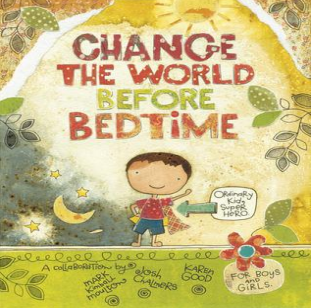
Change the World Before Bedtime
Mark Kimball Moulton & Josh Chalmers
A call to arms for social justice, this story’s inspirational message, multicultural ethos, practical approach, accessibility for the junior classes and simple, engaging rhyme persuasively show how small actions (such as a smile, a kind word, a simple deed) by everyone can help change the world. Each page of this book allows for learning and discussion about aspects of an ethical life, recycling, visiting old and sick people, farmers’ markets, planting trees, offering strong links to SESE. But the central message that our actions make a difference can build both responsibility and self-belief in children.
- As you listened to the story and heard about all the good things the children did, did you notice anything that you also do yourself?
- Could you ‘give a hoot’ and borrow a new idea from the children in the book? What would that be?
- How do you think the world needs to change? Why?
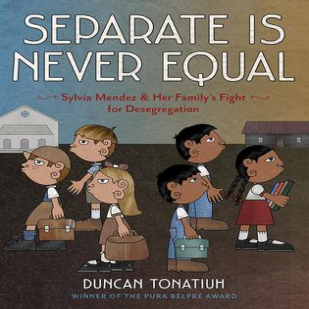
Separate is Never Equal: Sylvia Mendez and Her Family’s Fight for Desegregation
Duncan Tonatiuh
This nonfiction account for 3rd to 6th class, with excellent research and multimedia artwork, chronicles the struggle of the Mendez family against institutional prejudice and their successful lawsuit which brought about the 1947 California ruling against public school segregation. Cross curricular Integration could include histories of segregation and challenges to segregation around the globe. Children within the class can also tell their stories of inclusion and exclusion and the class can debate if laws need changing in Ireland.
- What do you think the children in the Mexican school were thinking and feeling before the change in the law?
- How would you describe the Mendes family and the decisions they took?
- What does the work injustice mean to you and can you name any injustice in Ireland today?
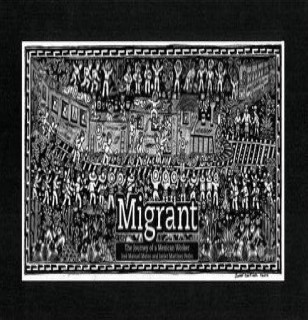
Migrant: The Journey of a Mexican Worker
José Manuel Mateo
This powerful story for the middle classes uses the immersive technique of a foldable accordion format (inspired by the codices of the indigenous peoples of Mexico and Central America) to chart a young boy’s difficult migration from his rural Mexican village to Los Angeles. This story provides a context for grounding learning about the UNCRC which may have taken place already. Children could look at the story through a human rights lens and explore how the rights of children are compromised in a situation of forced migration. They could then explore the areas in the world where children are experiencing migration today and also create a codex to tell a story of their own family.
- When Mam told the children they were leaving home and could only carry a few things in a bag what do you imagine they took with them?
- During the journey from Mexico to Los Angeles when do you think the children were most afraid?
- What do you understand (or want to understand) about why they left their own country?
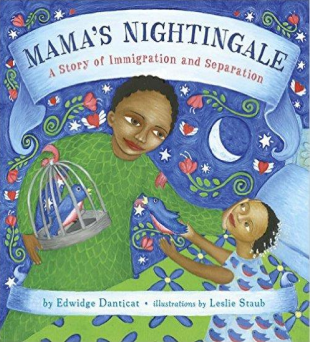
Mama’s Nightingale: A Story of Immigration and Separation
Edwidge Danticat
This serious yet hopeful tale (suitable for the senior classes) of parent-child separation and immigration interweaves Creole words and oil paintings evoking Haitian folk art in its depiction of the experiences of Saya, whose Haitian mother is incarcerated in a US immigration detention centre. Moved by her mother’s Haitian bedtime stories and her father’s political attempts to reunite their family, Saya writes a story to raise awareness and to try to help bring her mother home. The story introduces the idea of ‘papers’: passports, visas and work permits and invites a study of Haiti and an enquiry into why people leave and go to the USA without papers. Children could imagine the letter Saya wrote and explore what letters they themselves would like published in newspapers here. Senior classes could also discuss American policy on immigration, which is widely debated in the media.
- What do you think Saya misses most about her mother?
- How does Saya hold on to her mother’s love when she is away?
- Why do you think the lady reporter wanted to print Saya’s story and interview her?
Counting on Community!
Through counting up from one stuffed piñata to ten hefty hens– and always counting on each other – this warm and inviting book will encourage young children to recognize the value of their community, the joys inherent in healthy eco-friendly activities, and the agency they possess to make change. Cross curricular opportunities involve gardening, drawing with chalk, talking to and interviewing community members about what matters in our own place, project work about environmental possibilities in the children’s own communities and the making of our own placards.
- The children in this community seem to have lots of things to do. Which picture did you like best and why?
- Is there anything these children are doing that you would like to try too?
- What do you think was written on the placards? What does the community care about? What does your community care about?
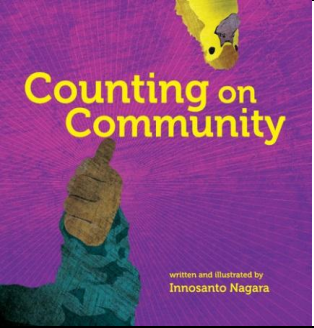
9. Global Children's Narratives

Terezin: Voices from the Holocaust
Ruth Thompson
During WW2, the Nazis transformed the Czechoslovakian town of Terezin into a ‘show camp’ whose inmates were forced to use their artistic talents to fool the world about the realities of concentration camps. Told through inmates’ own artwork, secret diary entries and first-hand accounts, this book will act as a powerful and valuable platform for discussion at senior-class level. In this book the life of the Jews in Terezin is shared through the words and pictures of the people themselves. It is a rich resource for history lessons. But a reading also prompts questions and emotional responses and offers possibilities for integrated History/ SPHE learning and philosophical questioning. Teachers may need to focus on particular pages at times for in depth discussion.
- What human rights were denied to the people of Terezin?
- In what ways did the Jewish people work and live together to try to survive in the ghetto?
- How do you think it happens that the Nazis and other groups today can inflict so much suffering on
others?
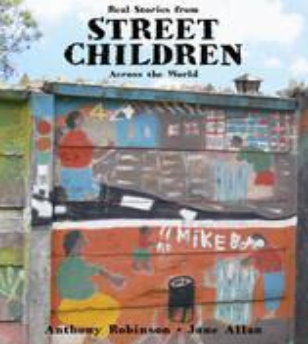
Real Stories from Street Children Around the World
Anthony Robinson & Jane Allan
Using drawings and photographs, this book unsentimentally though sensitively presents six children’s descriptions of the challenges and resilience of their lives on the streets in Zimbabwe, Guatemala and Mozambique. A powerful and valuable reading and discussion experience across the middle and senior classes. When children read about others who are denied rights, they can react with a degree of outrage. It is important that some action emerges from this if children are not to feel disempowered. Children could be encouraged to identify parties concerned and write letters expressing their concerns.
- As you read through the book, is there one particular child’s story that stayed in your mind? Can you say why?
- What do you admire most about that child? If you could ask that child one question what would it be?
- What is it about that child’s life that angers you or worries you? Look at the United Nations Convention on the Rights of the Child). What rights are denied to street children?
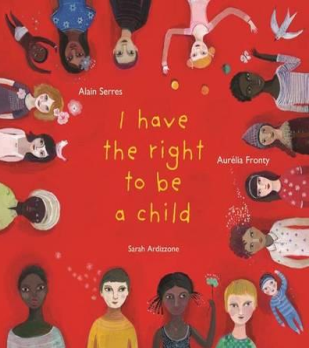
I Have the Right to Be a Child
Alain Serres, Aurelia Fronty & Sarah Ardizone
‘I am a child with eyes, hands, a voice, a heart, and rights.’ Written in first person from the perspectives of children, this multi-layered teaching resource offers rich opportunities for middle and senior classes to read and respond to at their own levels regarding the big questions about what it means to have rights in today’s world. Children have the right to know their rights and this book offers an engaging entry into global awareness and learning about the UNCRC, its history and vision, developing children’s own critical literacy and their use of a human rights lens through which to explore children’s lives. The book offers a wide range of cross curricular and project potential as well as an invitation to further researching and reflecting on the history of children’s rights, responsibilities and social justice locally, nationally and globally.
- What feelings did I notice as I read the book and can I explain why those feelings came?
- What do we think when we learn that many children are not protected?
- When you are a grown up what will you do to make sure that children enjoy all their rights?
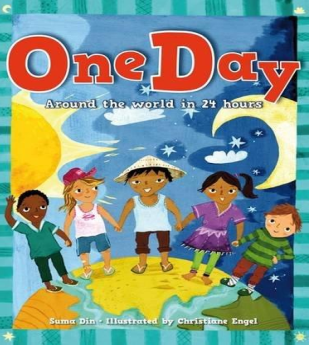
One Day: Around the World in 24 Hours
Suma Din
The attractive, accessible book for the middle classes demonstrates the concept of time zones through the narrative of children’s daily lives around the world. This device opens up rich opportunities for discussing similarities and differences across cultures, landscapes, climates, food and homes, and for critically reflecting on issues of globalisation, class, power and identity. The book
offers a way to ground learning about time zones in Maths and SESE. The countries in the book can be studied further in groups through project work. Children can name all the people they know, who live in other countries, and construct their own time zone maps. As a teacher listens to the children’s responses s/he assess the attitudes of children to people from other cultures and this listening could inform further planning for Intercultural education.
- How does the story of one child in this book remind you of the story of another child from the book?
- If you could live with one child from the book for a day, whom would you most like to visit and why?
- What needs to happen for the world to be fair for all children?
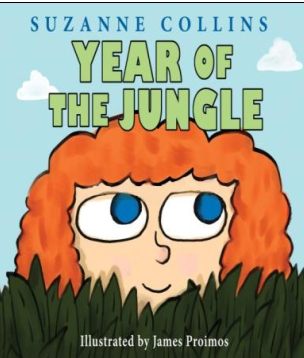
The Year of the Jungle: Memories of the Home Front
Suzanne Collins
The author of The Hunger Games draws on childhood memories of her soldier father’s absence while fighting in Vietnam in this moving, empathic story (suitable for senior classes) about the anxieties of children growing up during wartime. Children today encounter many images of war on the television and need adults to help them make sense of what they see. This book could offer two levels of engagement. Younger children could follow the thoughts, imaginings and feelings of the little girl and explore how important her Dad is to her while older children could debate how much information young children need to know about war, allowing them to explore their own vulnerability in a somewhat distanced way.
- The little girl did not know very much about war when her Dad went to Vietnam. Was that a good thing or a bad thing?
- What happened to make things get scary for her?
- How did you feel when the little girl’s father came home? Can you explain?
10. Environment

Aviary Wonders Inc.: Spring Catalog and Instruction Manual
Kate Samworth
This hypothetical catalogue imagines an all-too plausible dystopian future when birds are extinct and consumers can buy customisable avian automatons. 5th and 6th classes will gain much from this compelling and thought-provoking exploration of consumer culture and the responsibilities involved in humanity’s relationship with nature. Children could learn about the birds, which live in the school grounds, study their habitats and understand how humans can respect and preserve those habitats.
- Would you like to be a bird which some person could design the way they wanted to?
- Do you think people should have the power to design birds and other creatures?
- If the birds of the world could speak what do you think they would say to humans?
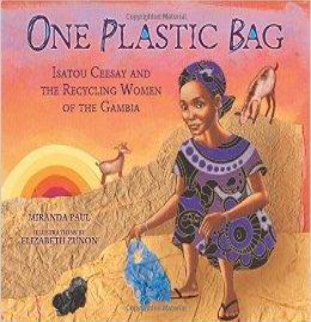
One Plastic Bag: Isatou Ceesay and the Recycling Women of the Gambia
Miranda Paul
During the 1980’s Gambian roadsides were being choked with ever-growing piles of non-biodegradable plastic bags. This well researched and beautifully illustrated true-life account of Isatou Ceesay’s environmental activism and her ingenious solution will inspire young readers in the junior classes to think about how they, too, can make a difference in their local and larger contexts. The story offers an entry into a study of the environmental effects of plastics. It also offers an entry into learning about the Gambia and community initiatives. Children could also research the Irish policy of paying for plastic bags, the rationale and the effects of that policy. Children could find a way to make something new from old plastic bags.
- What surprised you most about plastic bags as you listened?
- Can you find a word to describe Isatou and her friends? Explain your word!
- Do you have an idea for using plastic bags in a new way?
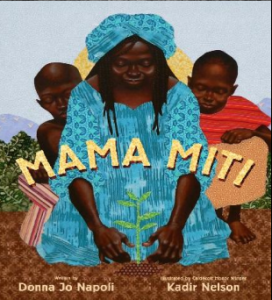
Mama Miti: Wangari Maathai and the Trees of Kenya
Donna Jo Napoli
This inspiring story of the founder of the Green Belt Movement, an African grassroots organisation, that has empowered thousands of people to mobilise, combat deforestation and environmental degradation, offers many rich opportunities for discussion for the junior and middle classes. The story can offer a starting point for studying the role of trees in sustaining livelihoods. Children could research the role of trees in climate change and the effects of deforestation as well as researching
local Irish trees, their particular value, the Greenbelt Movement, the Nobel Peace Prize, and planting a class tree. Children’s own actions in terms of reusing, restoring and recycling wood could be challenged.
- What do you feel is the most important way in which trees could allow people improve their lives?
- How do you think Wangari knew so much about each tree?
- All the tree planting and spreading of ideas were done by women. What do you think the men were doing?

Flutter and Hum: Animal Poems
Julie Paschkis
This dual-language (English and Spanish) illustrated collection of 12 poems about the beauty of the natural world will offer the senior classes many opportunities for debate, critical conversations and creative writing. This beautiful book needs no analysis, simply a response. However it opens space for an appreciation of the natural world at a time when many species are under threat. The bilingual aspect offers an invitation to any class to create their own version of Flutter and Hum, with the languages of the class represented. Migrant children can start with their mother tongue while Irish children can write as Gaeilge. Parents can help with the translations and come to view the final product.
- Choose one animal in the book and think of a question you would like to ask that animal.
- Choose an animal and research what habitat they thrive in.
- Choose an animal you love, take a photo or draw a picture and write a poem in your two languages
Counting Lions: Portraits from the Wild
Kate Cotton & Virginia McKenna
This counting story’s stunningly-detailed illustrations and poetic text explores the threats to endangered creatures and their habitats and what we can do to save them. Ideal for the junior classes. This book can be explored in any class in the primary school from enjoying counting to rich language development (e.g. the terms ‘threatened’, vulnerable’, ‘endangered’) and to conduct more research on these terms and other animals. This book can be used in tandem with others in this resource to explore the relationship between animals and humans and can support ethical practice in the future. It can also provide a stimulus for photography, drama and poetry.
- Which picture do you like best and why?
- If you could live the life of this animal for a day what would you learn?
- Look closely at the animals and imagine what they would like to say to humans?

- Feature photo: elisavhout (December 14 , 2010) books via Flickr (CC BY-NC-ND 2.0)
- This feature is based on titled ’50 Picturebooks to Change the World!’, a workshop document produced by Thérèse Hegarty and Patricia Kennon, Maynooth University, for the SPHE Network conference in November 2016.
